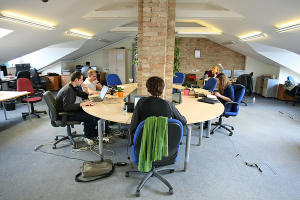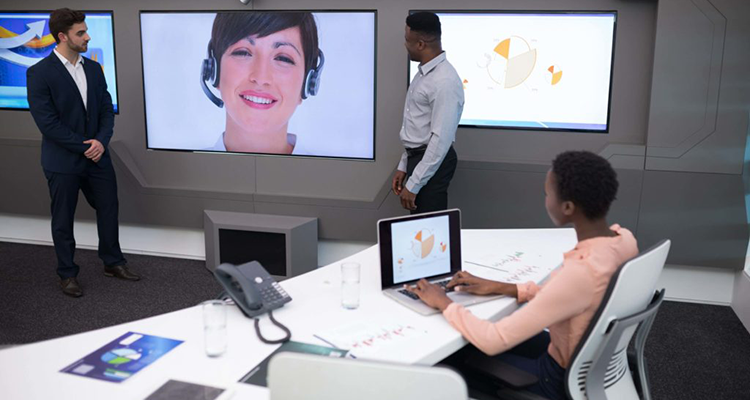Three Things I Want to Learn at InfoComm and Three Things I Already Know
Editor’s note: This column was printed just prior to InfoComm 2015 this year, but we thought you’d still find it interesting. See all of rAVe’s InfoComm 2015 coverage here.

OK – InfoComm is just around the corner. Along with ISE, it’s the largest audiovisual tradeshow of the year. Anything related to display systems, room control, audio distribution, media streaming and collaboration makes an appearance at the show. I’ve been attending InfoComm since 2007 and as much as I am tempted to predict the “coolest” things to appear at the show, I thought it’d be more interesting to point out what I hope to learn. There are things I don’t have a handle on — but I’m sure after finding and talking to the right people, things will come to light at the show.
Here are the three things I hope to learn at InfoComm:
 1. What does WebRTC mean to AV?
1. What does WebRTC mean to AV?
WebRTC is an open source Google project that provides browsers with the ability to act as a real-time communications (RTC) endpoint. It’s already disruptive in the unified communications (UC) space and will likely impact the AV industry as well. WebRTC provides a set of free APIs that allow anyone to enable voice, video, and text communications capabilities in a browser. Using WebRTC, webpages can plug in web conferencing capabilities into a HTML5 webpage. Very cool – we’ve already thinking about how this can be folded into the collaboration ecosystem.
Beyond providing endpoint capabilities, WebRTC can provide voice and video services. Just like a traditional PBX, incoming WebRTC calls can be transcoded into the SIP protocol and routed into the enterprise network. Does this mean that AV companies can introduce UC capabilities into their own products? It could, as long as those companies are willing to embrace a software roadmap. I’ll be looking for companies that are aware of WebRTC and are looking to leverage, and those that will miss.
Booths I hope to visit on this topic: Crestron (room control/RL), PolyCom (they are already in the WebRTC game), Smart, and Jupiter (Canvas 3.0 would be very cool with built-in UC).
2. Does digital signage have a future?
The market for complex and expensive installation of large-scale signage infrastructure is quickly disappearing. The signage model that was built on expensive (but smart) player systems connected to dumb displays is being challenged by Smart TV and the Android TV initiative. For very little expense, I can install a set of Android TV units, download a media player and connect those units to an existing wireless network. These same displays are touch enabled, and I’ve already seen R&D demos of units that can recognize viewer demographic with a built-in front-facing camera. Of course content authoring and centralized management will still have a future, but it’s unclear to me how digital signage as a separate product/market will survive the world of pervasive media streaming to consumer displays.
Booths I hope to visit on this topic: Panasonic (The company is releasing Android TV units this year — will they combine those with their signage business?), BrightSign (they may be a bellwether for the future of signage), and Tightrope Media Systems (they provide content design as well as integration and signage management so their perspective will be interesting).
3. How will the market react to the millennial workspace?
 I’ve blogged about this one before. Closed-door, fixed configuration, and dedicated rooms are evaporating quickly. This means that AV needs to transform itself from dedicated products and fixed AV designs to something more malleable. The workforce will change dramatically over the next five years as tens of millions of millennials enter the workforce. Their work style, approach to collaboration and problem solving, as well as their cognitive approach are defined by the technologies they grew up with – instant access to the internet through mobile devices and high-tolerance for multi-tasking. I’ll be curious to see how companies that are still building dedicated “room systems” will respond.
I’ve blogged about this one before. Closed-door, fixed configuration, and dedicated rooms are evaporating quickly. This means that AV needs to transform itself from dedicated products and fixed AV designs to something more malleable. The workforce will change dramatically over the next five years as tens of millions of millennials enter the workforce. Their work style, approach to collaboration and problem solving, as well as their cognitive approach are defined by the technologies they grew up with – instant access to the internet through mobile devices and high-tolerance for multi-tasking. I’ll be curious to see how companies that are still building dedicated “room systems” will respond.
Booths I hope to visit: Oblong (Mezannine is a dedicated, fixed configuration and expensive room system), Smart (kudos to them for the Smart Kapp product that can be deployed just about anywhere), Prysm (larger cube walls that require dedicated space for deployment).
OK — I don’t want to scare anyone into thinking the market is in danger — it’s actually an awesome time to be in the space. Each of these questions represent opportunity.





